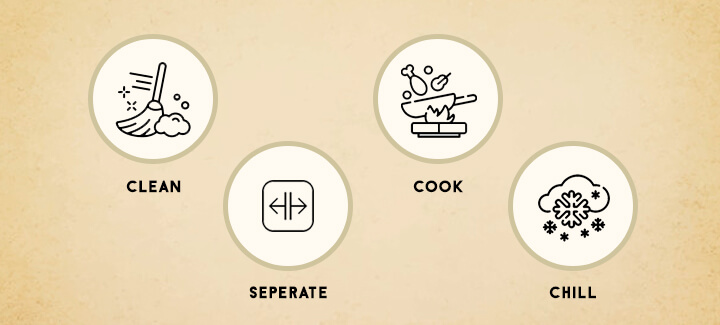The common belief that foodborne illnesses begin in the kitchens may be right to some extent. Yet, at the same time, foodborne illnesses can begin even before the food production stage. In other words, food contamination can happen long before it reaches the kitchen. Food gets contaminated with bacteria, viruses, parasites, toxins, and chemicals. Bacteria and viruses are present in raw meat, seafood, and poultry products. Whereas, certain food compositions can trigger allergic reactions. Storing food at wrong temperatures or not following hygiene practices can also lead to food contamination. Preventing foodborne illnesses should be your top priority.
Symptoms of Food Poisoning
Most foodborne illnesses have mild symptoms, and one can get cured in a short span of time. Common symptoms of foodborne illnesses are diarrhea, nausea, fever, and stomach cramps. These symptoms subside as the body gets rid of bacteria and germs. In case of severe symptoms, one may need to seek medical attention. So how to prevent foodborne illness and protect the family and consumers. Let’s take a closer look at how to optimize food safety:
Ways to Optimize Food Safety
Cleanliness
Get food products from authorized suppliers that handle food safety norms and parameters. Always check for the cleanliness of the storage area and the food products. Check for the freshness, and food should not have any bad smells.
Packaged Foods
Avoid purchasing the packaged foods that have dents in their cartons or cans. Never pick the jars with cracks and loose lids. Dents can make room for bacteria to seep into the food, thereby making it unsafe to consume. Any loose jar lid indicates that the container has lost vacuum and the product is contaminated. Never buy any tampered packaged or processed food even if there are discounts on it. Never consume any such food even if it looks fine to consume. Such food items might have got contaminated and can result in food poisoning. The bacteria might be present in a minute form that is not visible to the eyes.
Read Labels
Food labels provide information on its ingredients, cooking, and storage instructions. It also provides dates for which food is safe to consume. So, before buying the products, always read the labels. Buy only those items with allergen-free ingredients. Check the dates and consume the foods before the specified “use by” and “Best before” dates end. Eating past this date puts your health at risk. Consuming foods after the specified dates can lead to foodborne illness.
Frozen Foods, Meats & Poultry
While buying frozen products, ensure the packets are well-sealed and not crushed on the edges. Check for the freshness of eggs, ensure eggshells are free of cracks, and have no foul smells. Ensure that you place meat and fish products in separate bags. This will prevent the drippings from contaminating other food items. When buying ingredients, pick frozen and perishable items in the end. If possible, have an icebox in your vehicle to carry frozen foods. Accept frozen foods from suppliers only when they take them out of the freezer. Warm temperatures are perfect for bacteria to multiply, and it results in contamination.
Recommendation: Salmonella and Eggs: The real dangers and how to prevent them
Food safety in the kitchen
Once in the kitchen, follow the following safety norms to prevent foodborne illnesses.
Clean Hands & Kitchen Surfaces/Equipment
Prevent bacteria spread by washing hands at frequent intervals with soap and water. Ensure to wash utensils, chopping boards, and knives before and after food preparation. To avoid contamination, wash hands between the handling of foods like meat and fish. Keep separate knives, chopping boards for meats and fish to avoid cross-contamination. Always wash utensils, countertops, chopping boards with antibacterial cleaning agents before closing the restaurant.
Separate Food Products
Microbes get transferred from one food to another. Keep raw meat, seafood, eggs away from other food to avoid cross-contamination. Store meat, poultry, and seafood in separate bags to prevent their juices from mixing into other foods. Store eggs in their original carton. Keep an individual set of knives, chopping boards for fruits and vegetables.
Temperatures
Maintain storage and cooking temperatures to kill bacteria and prevent foodborne diseases. Use a thermometer to check the temperature of meats, poultry, etc., is even and safe. Food storage temperatures in refrigerators should be 40ºF to prevent bacteria spread. Refrigerate meats, poultry products, fish and defrost them before cooking them. Do not store cooked foods for a long duration.
Wrapping Up
Following the food safety tips and tricks right from the point of you buy the food product till kitchen. Cleanliness is the key to prevent foodborne diseases. While preparing food, ensure to follow food safety norms to keep food safe to consume. Undertaking the necessary training and becoming the holder of a food safety handlers card is an indication of you having all the knowledge and being qualified to handle food professionally.

